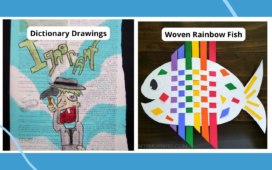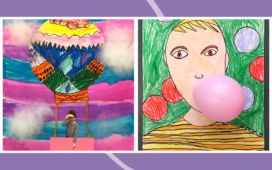As teachers, we see firsthand how kids of all ages need to play. We understand how various types of play can be catalysts for learning, social-emotional growth, physical development, building executive functioning skills, and creativity.
Jill Vialet, play advocate and founder of the national nonprofit Playworks, goes even further, saying in her recent book Why Play Works, “Play is the antidote to disconnection, isolation, fear, distrust, and despair. … It is a source of joy that facilitates understanding across difference.” Vialet also speaks often of how play can build relationships and build equity: “Play is the original amateur activity,” she writes. “[Playing together] means we are able to share our experience in a similar way.”
Download our free printable checklist with tips for supporting different types of play at school—for both little and big kids! Just fill out the form on this page to get your copy.
Jump to:
The Challenge of Play Today
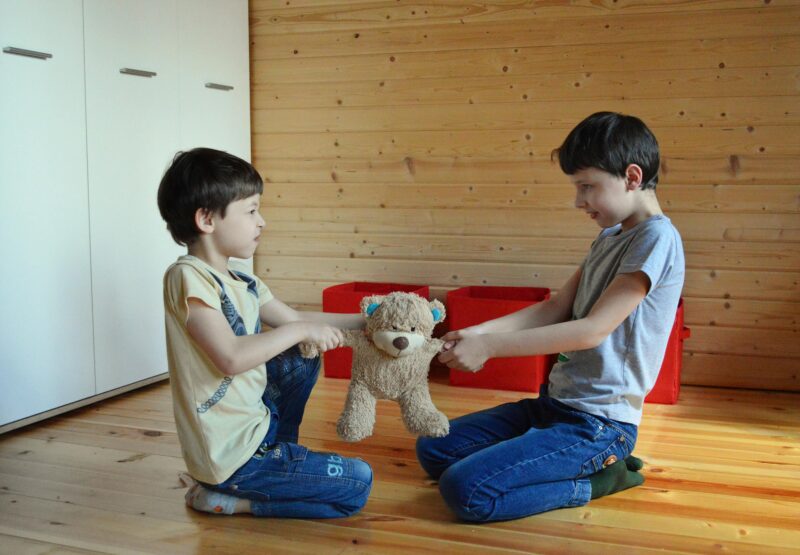
With today’s jam-packed curriculum, testing pressure, and academic expectations getting pushed down to younger kids, building play into the school day can be a challenge. Research backs up what many teachers instinctively worry: The past several decades have brought significant declines in children’s playtime, attributed to a tangle of barriers like over-scheduling and a lack of adult availability and safe play spaces. Pair these drops with data about skyrocketing screen time for kids and it’s clear: Play needs our attention.
Play and Learning
Academic time and playtime at school don’t need to compete with each other. Kathy Hirsh-Pasek, psychology professor at Temple University, has extensively researched strategies for leveraging play to drive learning. In 2023, her team received a multi-year, $19.98 million grant from the LEGO Foundation to follow of kids in classrooms using their “active playful learning” approach from pre-K to 4th grade. She doesn’t think play is only for little kids, though: She even uses her playful teaching and learning approach in her college courses!
Hirsh-Pasek’s research supports all types of play, but it emphasizes the potential high impact of “guided play” on student learning. She says guided play means “you can teach content in a playful way. … You can have a learning goal, but you can set up an environment so that the children do that exploration and discovery. They’re the agents of their own learning.” If you do it right, she says, it will mean “teachers have more fun teaching again, and therefore the kids will have more fun learning again.” Sounds good to us!
To be champions for kids’ opportunities to play—and learn playfully—at school, it helps if we can speak to its unique value. We also need to have strategies to include play across the entire day. To help, we’ve pulled together information about different types of play, how they benefit kids, and tips for promoting them in schools.
Learning To Play: 6 Stages of Play Development
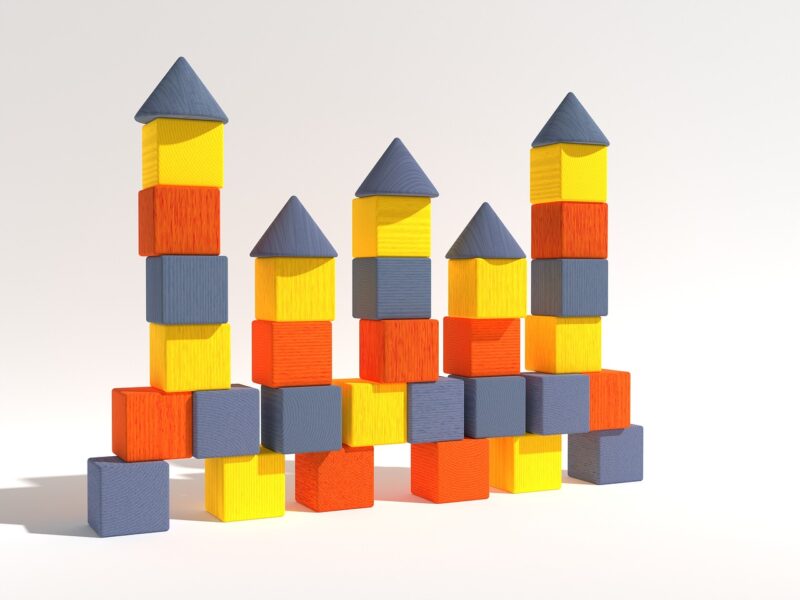
Sociologist Mildred Parten conducted extensive observations of children during free play back in 1932, and child development experts still refer to her “Six Stages of Play” today. Even if you mostly observe kids at more mature stages in your classroom, it’s helpful to keep the entire progression in mind.
1. Unoccupied Play
With unoccupied play, children randomly attend to anything that grabs their interest, without interaction or organized purpose. Children might manipulate items and experiment with how they can control them—for instance, an infant moving their fingers in front of their face. Unoccupied play can also include repetitive behaviors like spinning or banging.
2. Solitary Play
During solitary play, children play without noticing others around them. This stage can include the earliest examples of “object play,” when children explore ways to use toys or other items. (Anyone who’s watched a toddler play with the box instead of the gift has witnessed the appeal of “other items”!) Children in this stage can also begin “practice play,” repeating the same actions again and again, like opening and closing a door or rolling a toy car. Solitary play helps children build skills they can eventually use to play with others.
3. Onlooker Play
This type of play is similar to adult “people-watching.” Children take interest in watching others play and learn about how they interact with materials and other people. Onlooker play can overlap with solitary play.
4. Parallel Play
Parallel play happens when children play alongside one another but not with one another. They might use the same materials, like blocks, cars, puzzles, or dolls, but they don’t interact. This type of play can be thought of as preparation for playing together.
5. Associative Play
This stage marks a big transition from playing alone to playing with others. During associative play, children play together but without organization or collaboration. Picture a group of children all playing with blocks, but each one builds their own building.
6. Cooperative Play
This mature play happens when children start to plan and negotiate with others about how play will go. Imagine a group playing “store,” talking through who will be customers and employees. Or kids on the playground planning a tag game, discussing rules and who will be “it.” A big piece of cooperative play is navigating disagreements and emotions; adults are often important facilitators to help children learn the nuances of cooperative play.
7 Types of Play
Play is so varied and complex; different types of play emphasize chances for kids to grow in different ways. Here are some essential categories of play and ways to promote them at school. Many terms come from the Work of Play theorist Bob Hughes. Of course, keep in mind that many engaging play experiences end up including more than one type of play!
1. Social Play
Social play includes all types of play that involve relating to others. This play gives children chances to use language and practice social conventions like taking turns, sharing, and playing games with rules. Cooperative play is inherently social. To encourage it for younger kids, strategically offer materials that necessitate it. For instance, put a large funnel and bottle in the water table that takes two sets of hands, or set out only two baby dolls in a space that fits four children playing. For older kids, pose academic tasks as cooperative challenges that require kids to take on different roles. (Plus, check out our list of teachers’ favorite cooperative games.)
How To Encourage Social Play
Competitive play can be a powerful social play experience for kids to practice navigating intense emotions, cope with mistakes, and build resilience. Set up friendly competitions to practice academic or behavior skills, or use quick contests to energize kids, like Minute To Win It games. (And when it’s time to review concepts, we all know how middle school students love quiz games like Kahoot!)
2. Physical Play

Physical play is active. By running, jumping, and climbing and using playground and sports equipment, children get exercise and develop both gross and fine motor skills, coordination, and balance. (Play that centers around large body movements can also be called “locomotor play.”) Physical play hinges on having space and freedom to move, indoors and outdoors.
How To Encourage Physical Play
Helping all children learn playground games is a powerful promoter of physical play. Physical play isn’t just for recess, though; research suggests it can help kids learn. Use playful movement to understand concepts—like working together to come up with actions to represent vocabulary words, or pairing movements with memorizing math facts.
Physical play can be about testing limits. Intense “deep play” that feels like “flirting with danger” can help children practice risk taking and overcome fears. Have conversations as a school about risk-benefit assessment to see where you can reasonably give space for kids to test their boundaries. (For example, maybe it will work to let kids climb that tree but only if they have a spotter.)
3. Dramatic Play
When children pretend to be vets taking care of stuffed animals, or stage a playground pirate voyage, they’re enjoying dramatic play. It’s also called “fantasy play,” “imaginative play,” or “role-play.” These types of play let kids try out identities, emotions, and scenarios in a safe context. (Symbolic play—using something to stand for something else, like pretending a block is a phone—is a key cognitive leap needed for dramatic play. It’s often one of the first adorable signs that young children are learning to pretend.) Dramatic play is a gold mine for social-emotional and language development.
How To Encourage Dramatic Play
For younger kids, providing a variety of props during playtime can easily spark dramatic-play interests. (Check out our Teacher-Approved Picks for Dress-Up and Creative Play for ideas.) Offering props that connect to your curriculum lets students practice related language and review concepts while they play, like setting up a pretend farm stand when learning about plants. Use dramatic play as a teaching strategy too—for instance, having kids “act out” an upcoming event or conversation as a way to prepare and ease anxiety. Older kids respond well to role-play too, as long as they’re comfortable in the class setting. In addition to projects like dressing up to present a historical figure, try short bursts of role-playing to help solidify understanding of concepts. For instance, have kids work in pairs and pretend they are important adults at a party or business meeting explaining an idea.
4. Communication Play
This play centers on using conversation, expression, and gestures to explore ideas and connect with others. Telling jokes and experimenting with poetry, song, or mime are all examples of communication play.
How To Encourage Communication Play
The fantastic thing about communication play is that it doesn’t require anything more than bodies or voices. It can often happen in short bursts, like during wait time. Younger kids love reading or speaking in silly voices, like a “squeaky voice” or “robot voice.” Or play “talking games” such as a round of 20 Questions related to your curriculum. Older students enjoy debating, or creating raps, songs, or poems that connect to class content.
5. Constructive Play
Constructive play happens when children use open-ended building toys or other loose parts to make something. This type of play includes a sense of purpose and planning. It helps develop creativity, flexibility, and understanding of STEAM concepts.
How To Encourage Constructive Play
In younger classrooms, give kids time for free play with building toys. Collect recycled materials for an ongoing makerspace. Use building tasks to help kids understand concepts, like having them build a model of an animal to show its various adaptations, or a 3D representation of a book’s setting. Older students can also build to show their thinking about books, science concepts, historical events, or geographic features. (Don’t get overwhelmed—or overwhelm students—by feeling like every construction project has to be over-the-top. A few minutes of constructing something with LEGO, cardboard, or clay as part of a lesson can be as powerful as that perfectly to-scale diorama.)
6. Sensory Play
Sensory play stimulates any of the five senses. Babies and toddlers are famous for using their senses for exploratory play—like mouthing, banging, or stacking and wrecking blocks. Sensory play helps kids of all ages learn and remember new information from their experiences, though. It can also be calming and help with emotional regulation. Plus, getting kids talking about their sensory observations is great for language development.
How To Encourage Sensory Play
For younger kids, protect time for water and sand play and other sensory tables or bins; look for ways to align them to your curriculum both indoors and outdoors. For all kids, relate materials they can touch to academic tasks, like using play dough to “squish” sounds in a word or create different geometric shapes. While taste can be a no-go at many schools, don’t forget about sound and smell! Try a blind-smell test game in science, or play together with incorporating instruments when reading poetry aloud.
7. Mastery Play
This type of play includes repetitive activities that help a child master a task or some aspect of their environment. Think of the toddler obsessed with opening and closing a door, the child who tries the monkey bars over and over until they can cross them, or the kids who work tirelessly to move that pile of rocks on the playground. Mastery play helps develop focus, perseverance, motor skills, and STEM concepts. It’s often both regulating and satisfying for children.
How To Encourage Mastery Play
To promote mastery play, build in time for free play or fun challenges when introducing classroom tools. (This works for early math manipulatives and science tools like pipettes and magnifying glasses, all the way through coding kits and microscopes). Look for chances to expose kids to unfamiliar tasks. For example, add manual eggbeaters to your water table, or invite big kids to play around with typing on a typewriter. Invite early finishers to work on solving manual brainteasers or puzzles, like a Rubik’s Cube. Provide access to natural materials outdoors to invite kids to “master” their schoolyard environment, such as branches and logs to make shelters or bridges across puddles.
Get Your Free Types of Play Printable Checklist
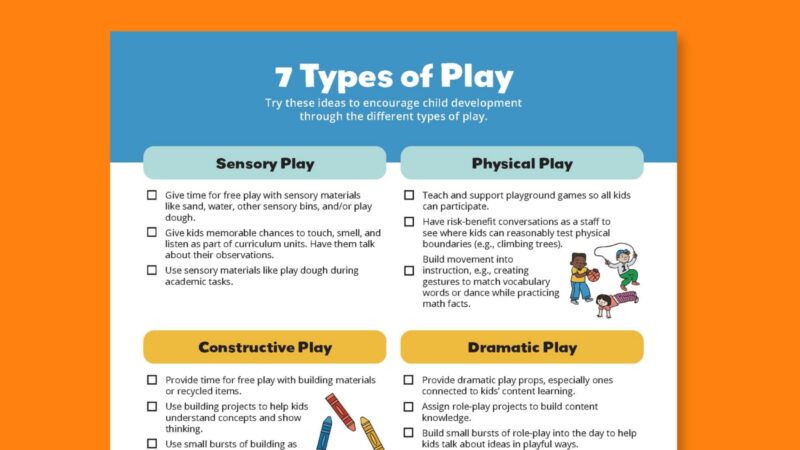
Just fill out the form on this page to get instant access to a helpful checklist with tips for encouraging kids to develop using the the different types of play.





